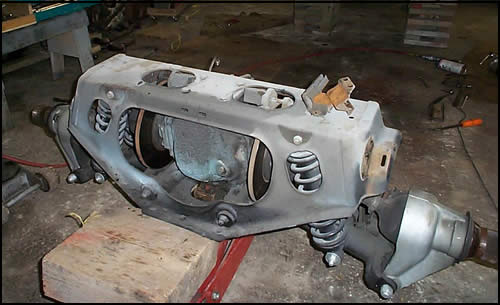The 'Ravensbourne Project' Part Two From the outset of this project, I was greatly influenced by Dan Mooney's approach to E-Type restoration. Since my work took me to the Austin, Texas area at that time, I had the opportunity to meet with Dan on more than one occasion, visit his workshops at Classic Jaguar and look over the many innovative performance equipment products he was developing. Dan, who is another Brit of course, is in my opinion, the leading Jaguar restorer and performance equipment supplier in North America. He is also the exclusive distributor for Suffolk and Turley and his upholstery shop is second to none. Therefore as you can imagine, much of the new equipment on my E-Type came from Classic Jaguar. The majority of the remaining new or replacement parts came from XK's Unlimited, a long time supplier for our Jaguar cars, and it's interesting to see that Jason Len and his team are also now aggressively expanding more and more in the performance equipment arena.
This relatively new phenomenon of moving away from pure E-Type authenticity, (aside from the earlier lightweight and replica initiatives), to the more exciting experience of performance enhancement for the regular E-Type driver, has some purists shaking their heads. However, after you have experienced driving an E-Type with triple Webers, a cooling system that does not overheat, even under the most stressful of conditions and a calibrated front and rear shock absorbsion system that allows you to select the ideal ride, you'll never look back! This is not to say that I have not retained all of the original authentic components removed during the restoration process. Indeed they have been carefully cleaned, painted and stored away so that the car can be readily returned to original condition should that be desired at some point in the future.
The new alloy radiator, with its powerful fan and stainless expansion tank are a huge improvement and were pretty straightforward to install. The Falcon stainless exhaust system, purchased previously from the late Dick Ames, had been installed then replaced with authentic Jaguar parts for a while. Now they were reinstalled with the manifold pipes already having that beautiful burnished gold and blue patina from previous use and a welcome sight back in the engine bay.
I decided to retain the original Lucas electrical harness, which was, in fact, in quite good condition. However, I did add a Mallory distributor. (After a full season's driving I have also decided to add an electronic ignition system in 2002). Also the high-tension wiring leads were repositioned to that more in keeping with the D-Type architecture. In the process, the 'Bakelite' plug wire conduit was first tried. (Bakelite is an old style unattractive brown colored plastic like material, quite extensively used in the UK at one time). Well, it still looked pretty ugly when installed, so I abandoned it for an alternative conduit made of billet aluminum. A great job was done of drilling through a slender piece of this material for the HT leads and when polished up and attached to the cam cover, looked absolutely terrific! (I was interested to see that Dan Mooney now offers a specially manufactured plug wire conduit and I'd like to think that the 'Ravensbourne Project' had some influence over this decision!).
Another innovation was the installation of a stainless oil catch tank in the area where the big old AC air cleaner had been housed. The top of the tank was modified to accommodate a matching cap which when removed, would allow for easier disposal of the accumulation of blowback oil. Especially pleasing has been the installation of Classic Jaguar's polyurethane bushings, up rated torsion bars and billet aluminum rack mounts in terms of improved steering performance. By far the biggest challenge was the installation and configuration of the three 45 DCOE Webers. Consultation with several experienced suppliers and the acquisition of an excellent reference book on these carburetion systems as well as experimentation with several sizes of jets, produced a very satisfying driving experience by the end of the driving season. Regretfully, putting aside the exciting look of those brushed metal Weber ram pipes, because of concern for the potential engine wear damage that could be sustained without adequate air filters, these will be replaced with the appropriate K and N filters this year.
The final stage of the Ravensbourne project was the removal and restoration of all rear end components. Once again, a first time operation since the car was manufactured and clearly a timely and as it turned out, necessary part of the overall program. These pictures illustrate the renowned independent rear suspension system, first introduced by Jaguar at this time and which was so technically advanced for that decade.
After several test runs, it was remarkable how quickly the E-Type settled down to a quite faultless driving experience, traveling up and down the Pacific Northwest throughout the summer months with only some minor tweaking to the Webers required and the fuel pump replaced after a visit to Vancouver. This year we'll take a break after eleven years of busy but successful concoursing, to just enjoy touring with the E-Type in its new configuration. It has certainly been a wonderful way to celebrate the fortieth anniversary year of the introduction of the Jaguar E-Type and in the same year as our own fortieth wedding anniversary! |
©Copyright 2001 - 2003 Bruce MacCormack. All rights reserved. Website by Cascadia Consulting, LLC
|






